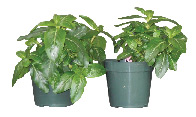Soluble Salts: Don’t Get Burned

As discussed in our previous article last month, high soluble salts can accumulate in the root zone when there is poor quality (high salt) irrigation water or excessive fertilizer input. Understanding which bedding plants are most sensitive can aid in crop selection and in management practices such as leaching.
At Cornell University we conducted an experiment to determine the response of 14 common bedding plants to increasing levels of high soluble salts. In this article we detail the growth effects on the studied species, provide a classification grouping for response to extreme salt stress and list corrective actions for high salts.
Bedding Plants For Salt Sensitivity
Table 1 ranks the bedding plants we studied for growth and height response to high soluble salt levels (PourThru EC 7.1). The irrigation water used for this treatment contained table salt (460 ppm Na + 710 ppm Cl) and had an EC of 2.4. This is roughly equivalent to the highest salt levels we have seen in New York state wells.
In one case, the high EC came from road deicing salts. In the other case, well water was in contact with a salt deposit. All plants examined except for fuchsia and snapdragon showed a significant reduction in plant biomass (measured as shoot dry weight). Coleus, Elatior begonia and zinnia were half the size of their control counterparts. Most affected were zonal geranium and euphorbia hybrid, which were both two-thirds to three-quarters smaller than control plants.
It is interesting to note that only seven species showed a significant reduction in height. For begonia, fuchsia, marigold, petunia, snapdragon, verbena and vinca there was not a significant reduction in height, whereas dry weight was significantly reduced at high EC. In a practical sense, this means a grower observing a crop purely from the standpoint of plant height may not detect a problem with high soluble salts (Figure 1). An astute grower of these crops may notice the problem appears first as sparser growth and a reduced leaf area.
The highest salt treatment in our experiment (1840 ppm Na + 2840 ppm Cl) was designed to look at plant response to extreme salt stress (PourThru EC averaged 14.5). Under these conditions all plants exhibited tell-tale signs of high salts: marginal necrosis (brown edges) on lower leaves and reduced plant size.
Of the 14 species, snapdragon (Figure 2) and petunia were the most salt-tolerant plants. Pansy and Zinnia angustifolia were the most sensitive. All plants were dead after five-week exposure to extreme salts.
From another experiment at Cornell, we also found New Guinea impatiens, sanvitalia and fibrous begonia are also very salt sensitive. All plants died in response to five-week exposure to extreme salts. While we’re not advocating growers use irrigation water anywhere close to this extreme treatment, it is amazing to note many of the bedding plants could grow (albeit slowly) and stay alive (at least in the short term) under these conditions.
Correcting High Soluble Salt Levels
Once root-zone salts have been determined to be too high, effort should be taken to determine the source of high salts. Test the irrigation water EC and the fertilizer solution EC. Compare the solution EC to the fertilizer label to make sure the correct rate of fertilizer is being applied. An error indicates improper fertilizer mixing or the injector ratio was not dialed in correctly. A New York grower reported discovering their plants got a 10-fold higher fertilizer rate than should have been received. Unfortunately, this wasn’t noted early on by checking the stock solution EC–it was noticed when leaf edges began turning blue from the fertilizer coloring agent.
Immediate action is required if there are visible salt damage symptoms on the plant or if root salt levels test in the high to very high range. In this case, clear water leaching is required. Irrigate each plant so about 50 percent of the applied water leaches out the bottom of the container (e.g. leaching fraction of 50 percent). Then recheck substrate EC values. If values are still too high, you can repeat the leaching procedure until EC is in the acceptable range.
Should you leach and re-leach if containers are already saturated with water? Yes! Waiting for them to dry out before leaching will compound the salt problem. Salt levels will become more concentrated as pots dry out, causing increased damage to roots. The best thing to do is to leach out the excess salts right away, then let the roots begin to recover in an environment with the proper EC.
Perhaps through periodic monitoring of the substrate you’ll find EC is just starting to become borderline high. The most probable cause of this is fertilizer salts being applied at a greater rate than the plant can absorb. In this case, leaching may not be required. Instead, take action to decrease the fertilizer rate. This can be done by switching to a lower concentration of fertilizer for plants on constant liquid feed or reducing the frequency of fertilization. For example, if you were previously fertilizing every time you water, switch so that clear water is used every second or third time you water the plants.
Coping With Poor Quality Water
When deciding where to site a greenhouse or nursery operation, the first consideration should be given to water availability and quality. What is the water source? What volume of water can be economically used per day? What is the water quality in terms of EC and alkalinity?
When a greenhouse operation faces poor quality irrigation water, there are essentially three choices: 1) filter the water; 2) seek a higher quality water source or 3) follow close management and plant selection decisions to minimize salt damage.
Several methods are available to filter the existing water. Reverse osmosis (RO) is most commonly used, as it tends to be the most cost effective. Reserve osmosis uses pressure to force water through a semi-permeable membrane that excludes most ions. With reverse osmosis, one consideration is disposal of the waste water containing the unfiltered ions. Depending on the RO unit and water source, 25 to 75 percent of water will not pass through the membrane and, thus, will need to be disposed of.
It may be more economical to find a different water source rather than filter existing water. Rainwater is of high quality for greenhouse plants (low salts, alkalinity) and is relatively straightforward and cheap to capture and use from gutter-connected greenhouses. A pond or large tank will be required to hold the water, and debris should be filtered before it enters the tank. This may be done using a device that diverts the first flush of rainwater and associated debris from entering the tank. If river or pond water is used, it should first be filtered (to remove debris suspended solids) and then disinfected (to remove pathogenic organisms) before being applied to plants.
Most operations that filter water or collect rainwater blend this with their original water. Some proportion of RO water or rainwater is added to their original water source to achieve a set EC set point (e.g. 0.7 or 1.0 mS/cm). Alternatively, pure water may be applied periodically to flush salts from containers. Caution: When switching water sources, you will likely need to change your fertilization/acidification practices. Consult with your Extension educator or commercial testing laboratory to determine what changes should be made. For example, if the original irrigation water is high in alkalinity and salts, an acidic fertilizer that doesn’t include calcium and magnesium may be appropriate. But if rainwater is used, calcium and magnesium may need to be added and the fertilizer should be less acidic.
Getting Creative
If operations do not have the ability to change their water source or filter high salt water, they must be both diligent and creative in their plant selection and care. These operations may need to follow one or several of the following suggestions:
– Grow only plants that can tolerate elevated salts.
– Grow plants with a quick production cycle.
– Minimize salt buildup by leaching frequently and using a porous, well-drained substrate.
– Irrigate frequently and keep substrate moist (so EC doesn’t rise as soil dries down).
– Avoid excessive inputs of fertilizer salts. Consider controlled-release fertilizers.
In summary, periodic monitoring of substrate EC is the best way to keep salt problems in check. Early detection and corrective action will go a long way toward keeping your plants and your pocketbook full of green.









